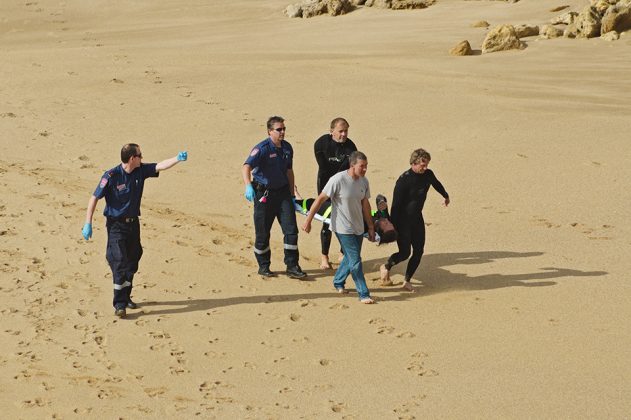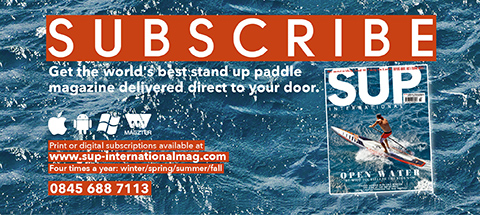FIRST AID –
#2 SURF INJURIES
Words – Gordon Ingram
In a previous issue we looked at the primary survey, the initial approach to assessing a casualty to ensure any life-threatening issues are spotted. This time we are going to take things a bit further and look at what we can do when we reach the end of the primary survey and have found no major problems. It is important to remember that if someone has broken an arm it will be painful; however it is not a life threatening injury.
The broken arm will not kill the patient; a hidden chest injury which they may have sustained at the same time could present to be a major problem. With this in mind we should always carry out a primary survey on each and every patient: CABCDE – The Primary Survey (Catastrophic bleed, Airway, Breathing, Circulation, Disability / Neurological Deficit, Extremity / Environmental Exposure). It is often difficult to ignore the fact that the patient is possibly in intense pain and being increasingly vocal when doing the primary survey, but it is imperative that any life threatening problems are ruled out.
DISCOVERING WHAT’S WRONG
Hopefully, when we are dealing with a casualty we will get to the end of our primary survey and have found no life threatening problems. At this point we can now look at any other problems or injuries that are causing pain and/or discomfort to the patient. The easiest way to ascertain any injuries that a conscious patient may have sustained is to ask the patient! It sounds simple but a conscious patient can supply you with a massive amount of information.
Things are a little bit trickier if your patient is unconscious; the easiest way to work out what injuries they have is by carrying out a Secondary Survey. In simple terms this is a head-to-toe check of the patient, looking along the whole body for any unnatural movement, deformity, tenderness, bleeding etc…, anything that may not be normal.
TYPES OF INJURY
So, what can we do and what are the most common injuries found? There are a wide range of injuries that we could sustain whilst in the surf and if we tie this in with the possibility of not having readily available medical care then our treatment will be important.
The injuries we are going to look at are sprains, strains, fractures, dislocations and cuts.
Sprains – a stretching injury to ligaments.
Strains – a stretching injury to muscle or tendons.
When in an environment with little or no medical care available, sprains and strains can be relatively well managed.
For the first 48 – 72 hours after the injury remember think ‘PAY THE PRICE AND DO NO HARM’
Protect – immobilise the effected limb
Rest – consider minimal movement
Ice – apply as soon as possible for 30 minutes – although there is mixed evidence regarding this!
Compression – a bandage will aid the reduction of swelling
Elevation – will limit and reduce any swelling
Do NOT allow:
Heat – encourages blood flow therefore should be avoided
Alcohol – increases swelling, bleeding and prevents further healing
Running – may cause further damage
Massage – may increase further bleeding and swelling
“ There are a wide range of injuries that we could sustain whilst in the surf and if we tie this in with the possibility of not having readily available medical care then our treatment will be important ”
Fractures/Dislocations
If we are presented with a limb that may be fractured or dislocated then we need to think very carefully about how we are going to help the patient.
The treatment of fractures and dislocations in a pre-hospital environment mainly involves immobilisation/splinting.
If a person has suffered dislocations in the past then they are generally more prone to having recurring dislocations in the future. Some people will wish for their dislocations to be relocated however this does carry several risks and should be avoided unless you are trained in how to carry out the procedure.
Splinting is a method to keep a broken bone, an injured limb, or a dislocated joint completely still. This can be achieved by simply holding/supporting the limb with your hands or it can be made more permanent by fixing a ‘splint’ (something rigid) to it.
There is a wide range of manufactured splints available (e.g. SAM™) along with improvised splints: paddle sections, wood, cardboard, foam sleeping mat, tent poles, the uninjured limb.
WHY SPLINT A LIMB?
A splint can reduce the risk of shock by controlling the pain and reducing bleeding of a fracture or dislocation. It will prevent any further damage to a broken bone, dislocated joint or injured limb by stopping any movement. It will also prepare the casualty for evacuation or other procedures.
If a patient has suffered an open fracture, then we must remember never to put any pressure onto the protruding bone. Any bleeding has to be managed by padding around the site and then immobilise the limb in a comfortable position. The difficulty comes when the blood supply past the point of the injury may be compromised. This is the point where medics would give the patient a substantial amount of pain relief and realign the injured limb. Again, not recommended without prior training and knowledge.
CUTS AND LACERATIONS
As summer is on its way here we will all be shedding those boots and cutting our feet to shreds! The faster you can treat your wounds, and manage them effectively, the more time you will have to enjoy the waves on your trip.
• Irrigate the wound with fresh water and ensure any pieces of debris are removed from inside the wound. Don’t be afraid to scrub the wound using gauze dipped in antiseptic as this helps to remove any foreign bacteria.
• Apply antiseptic to the wound. The antiseptic may sting but it is extremely important that any foreign bacteria are killed before they have time to damage the tissue within the wound.
• Keep the wound free of dirt and covered as much as possible. Using appropriate dressings for the type of wound.
• Re-dress wounds as required. Do not leave dressings on for more than 3 days.
• Infection is indicated by yellow pus within the wound site, and soreness/redness surrounding the wound site. If infection is present scrub the wound using gauze dipped in antiseptic. Once all the yellow pus is removed, re-apply antiseptic and dress appropriately.
• If you are lucky enough to be on a boat trip then many of the crew may be trained in suturing and gluing. This is great but if you don’t know how then don’t be eager to try!
• It’s very easy for me to say but try not to be tempted back into the water until the wound has healed. Warm sea water contains higher levels of bacteria and your wound will worsen rapidly!
As I said in the previous issue, we cannot cover every eventuality in this article and I urge you to enrol onto a suitable course and gain the knowledge you may need. I do hope you never have to act on this information but if you do it is always better to have the prior knowledge.
Take care, stay safe, Gordon. SUP
For more information on Gordon’s courses visit www.firstresponsegb.com


